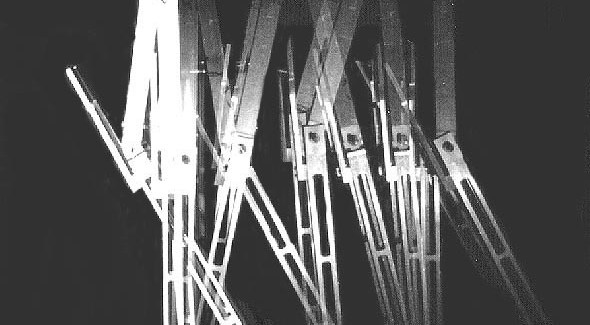Behavior based design
The idea of soft architecture emerges from a  need to design intelligent and living environments. Structures that are autonomous and exhibit properties of self preservation, regeneration and adaptation to changing ecology. Brodey’s Soft Architecture talks about the design of intelligent environments in context of exhibiting self organizing and evolutionary properties.
Virtual reality and interactive architecture have visibly exhibited such properties in parts. One of the common approaches to interaction design is to design for a perceived goal, usually a task at hand or a problem solver. Where the goal defines the methodology to achieve itself. The design is processed through input and output values, goes through various iterations to test  for failures. We process it for all possible situations, our minds are capable to think of.
The goal oriented design might create an unpredictable behavior where the morphology and choice of material play an important role, as studied by William Bondin. He argues that design should be behavior based rather than goal oriented. Behavior provides it the ability to take decisions and change the predictable course of action. Hence developing into a much stable ecology and system link. What are the other parameters that influence this behavior?  How can we design to achieve a desired behavior?
A set of behavior influenced by the morphology is exhibited in Theo Jansen’s Strandbeests which show an uncontrolled movement and respond to the environment they are placed . The passive dynamic walker developed by Mc Geer also exhibits a human like walking performance due to the mechanism and the material it is built with.
Similar to the behavior patterns of humans, which vary with surroundings, time and interaction with different subjects; the behavior patterns in machines and systems are also influenced or altered by external factors. The behavior generated could be predictable or non- predictable. It could be dynamic or transient.
An example of a soft jumping robot exhibits  its ability of self preservation  by encountering  collision to surface with a response to drawback itself.
Gordon Pask discusses about the interaction of system with the environment and feedback loops generated in the same context, which eventually talks about a social behavior for the intelligently designed environments. He developed the musicolour which is a machine which acts as a listener to the musician and provides him with a feedback of likes and dislikes while the musician plays on it. Pask’s various machines depict a sense of behavioral role play while interacting with human beings.
It is fascinating to study how their behavior influence the surrounding environment and reinterprets the behavior in the system. How will it develop itself to be regenerative, self preserving and adaptive? This invented ecology might have repercussion beyond reach of the human mind. In this digital era, where life seems impractical without the dependency on devices, it is more important to create intelligent devices which has a constructive impact on the behavior generated by this man machine symbiosis.
References:
- Nicholas Negroponte, Soft architecture machines, The MIT Press, 1975
- Neil Spiller (editor), Cyber Reader. Critical Writings for the Digital Era. An anthology of extracts from key texts relating to the theme of cyberspace, Phaidon Press 2002
- Brodey, Warren M. “The Design of Intelligent Environments: Soft Architecture.”Landscape, Autumn 1967, Vol. 17:1, Pp. 8-12; with Diagr. (1967).
- William Bondin , Embodied Dynamics: The Role of Externalised and Embodied Cognition in Kinetic Architecture, Bartlett School of Architecture, 2013






Submit a Comment